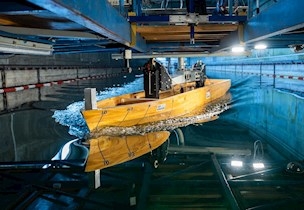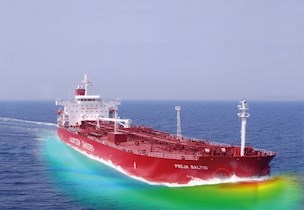Overtrawling
Subsea structures are required to be overtrawlable if they are not marked with a buoy or vessel. An overtrawlability test will indicate the critical areas.
Major damage may occur to the structure and technical equipment in case of an unfortunate hit of a trawl door. Furthermore, snag of trawl and trawl doors can create dangerous situations for the fishing vessel.
Overtrawlability tests will indicate where the critical areas with regard to the overtrawlability of the structure are located, and if necessary, modifications are suggested. No guarantees are given that critical situations cannot occur in full scale, but we can help ensuring that the structure is highly overtrawlable in model scale.
For structures with large openings, there is a risk that the equipment to be protected may be hit by trawl boards or clump weights penetrating somewhat into the structure. Such scenarios can also be tested and remedies proposed.
Testing of overtrawlability
Two types of tests are performed:- In-air tests where model fishing gear is dragged over a scale-model of the structure in order to identify potential snag areas. This is a cost-effective method which quickly identifies potential snag areas and permits changes to be tested easily.
- Tank tests where the fishing gear is towed over the structure in a representative way with particular emphasis on critical areas and approach lanes. These tests provide information on how the equipment actually functions and interacts with the structure. Furthermore, the trawl-wire forces are measured.
For both types of tests, It is important that a client representative is present and participates actively in the tests and the identification of possible remedies.
A report on the fishing activity in the area will be prepared by a fisheries expert who also identifies the fishing gear most commonly used in the area. The fisheries expert also helps selecting the fishing gear to be used for the model tests and provides scale models of the equipment. He also participates in the tests and ensures that the fishing gear is used in a representative manner.
The tests will be carried out in our towing tank, which has the dimensions 240 m x 12 m x 5.4 m (length x width x depth). The tank is equipped with a large carriage bridging the tank and running on rails. A trailing carriage is attached to the main carriage. This will be used to control the position of the “bird’s-eye-view” video camera and for deployment and recovery of the trawl equipment. The carriage assembly is used to tow the trawl net. The velocity of the carriage may be set at a pre-specified value and reproduced with high accuracy, thus providing identical towing conditions.
Please contact us if you wish to receive more information, or if you have any questions or inquiries regarding our overtrawling services.




